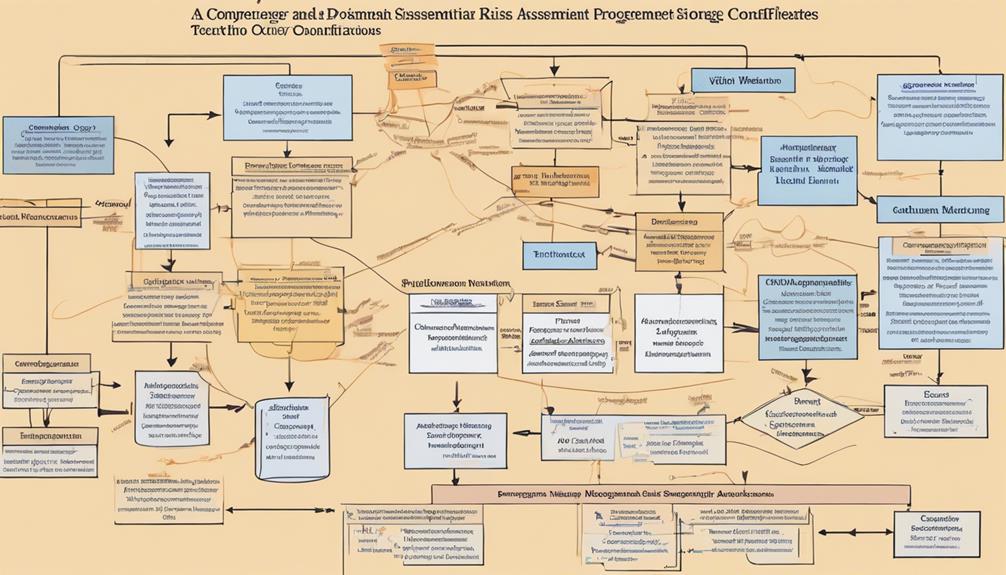Challenges and Risks Associated With Conglomerate Mergers

Conglomerate mergers come with a host of daunting challenges and risks that organizations must skillfully navigate. From conflicting corporate cultures and divergent strategies to onerous regulatory obstacles and financial strain, the process of integration is complex and demanding.
Breaking down organizational silos, promoting transparent communication, and effecting a fundamental shift are crucial for unlocking the full potential of the merged entity. Despite the significant hurdles, companies that proactively tackle these issues through strategic planning and decisive leadership can set themselves up for sustained success.
When different companies with diverse backgrounds and operational models come together in a conglomerate merger, the clash of cultures can hinder the harmonious integration of the organizations. It is essential to address these cultural differences head-on and create a unified culture that embraces the strengths of each entity while fostering collaboration and mutual respect.
Moreover, regulatory hurdles can pose a significant challenge during the merger process. Navigating through various legal requirements, compliance standards, and industry regulations requires meticulous planning and a thorough understanding of the legal landscape. Organizations must ensure that they have a robust compliance framework in place to mitigate the risks associated with regulatory non-compliance.
Financial strain is another critical risk factor in conglomerate mergers. The consolidation of operations, resources, and financial assets can lead to short-term financial instability if not managed effectively. Companies must conduct a comprehensive financial analysis, identify potential areas of cost savings and revenue growth, and develop a sound financial strategy to weather the initial challenges and emerge stronger post-merger.
In conclusion, while conglomerate mergers present formidable challenges and risks, organizations can overcome these obstacles by proactively addressing cultural differences, navigating regulatory complexities, and managing financial strain effectively. By focusing on strategic planning, open communication, and decisive leadership, companies can position themselves for long-term success and create a synergistic merged entity that is greater than the sum of its parts.
Key Takeaways
- Navigating diverse corporate cultures and aligning cultural differences to foster integration and unlock synergies can be a significant challenge in conglomerate mergers. Bringing together companies from different industries with distinct ways of working and values requires careful management and communication to ensure a smooth transition.
- Addressing antitrust concerns and obtaining regulatory approval is crucial in conglomerate mergers to avoid delays or potential merger collapse. Government agencies closely scrutinize these mergers to prevent monopolistic behavior and protect market competition, making it essential for companies to navigate these regulations effectively.
- Managing integration costs and financial strains is a key aspect of maintaining operational efficiency and long-term growth in conglomerate mergers. Combining diverse businesses can lead to increased expenses and complexities, requiring strategic planning and financial management to ensure a successful merger.
- Ensuring compliance with varied regulatory frameworks across industries and geographies is another critical risk in conglomerate mergers. Companies must navigate different laws and regulations governing their respective industries to avoid legal issues and maintain business continuity post-merger.
- Protecting core competencies and maintaining focus amidst the complexities of merging unrelated businesses is essential in conglomerate mergers. It is crucial for companies to identify and preserve the strengths that set them apart in their respective industries while also effectively integrating with new businesses to unlock synergies and drive growth.
Integration Challenges in Conglomerate Mergers
When companies merge in conglomerate mergers, they face inevitable integration challenges due to their unique cultures, operations, and systems. These hurdles often lead to employee resistance, goal misalignment, and operational disruptions.
Cultural differences, conflicting management approaches, and breakdowns in communication can all hinder the successful integration of conglomerate mergers.
Additionally, operational inefficiencies, duplicate functions, and redundant processes can complicate the integration process. To overcome these obstacles, effective leadership, clear communication, and strategic planning are essential.
It's crucial to establish a shared vision, align goals, and streamline operations to capitalize on synergies and ensure a successful merger.
Cultural Clashes in Diverse Businesses

Cultural clashes pose a significant challenge in conglomerate mergers, as we combine distinct corporate cultures, communication styles, and decision-making norms. Variations in values, expectations, and organizational structures can lead to conflicts in priorities, work processes, and overall integration. Aligning these diverse business cultures is crucial for fostering successful collaboration and ensuring long-term prosperity.
Neglecting to address cultural clashes can result in employee disengagement, reduced productivity, and retention issues, ultimately undermining the intended benefits of the merger. Effective communication, cultural awareness training, and alignment among leadership play pivotal roles in overcoming these obstacles. By promoting mutual understanding and adapting to each other's work styles, we can navigate the complexities of cultural integration and unlock the full potential of the conglomerate.
Proactively tackling cultural clashes is essential for unlocking the synergies and innovations promised by conglomerate mergers. With the right approach, we can harness the strengths of diverse businesses to drive competitive advantage.
Aligning Strategies Across Unrelated Operations

In conglomerate mergers, it's crucial to align the strategies and business models of the different entities involved. This alignment goes beyond just addressing cultural differences; it requires creating a cohesive vision and objectives that can be effectively implemented across the diverse portfolio.
There are several challenges to aligning strategies in conglomerate mergers:
- Bringing together varied business models and goals to create synergies.
- Establishing a common language and understanding of the strategic priorities of the merged entity.
- Ensuring that communication and leadership are effective in driving alignment.
To succeed, companies need to invest time and resources in developing a unified strategy that can be seamlessly executed. This involves analyzing the strengths and weaknesses of each business, identifying areas of complementarity, and crafting an overarching vision that resonates throughout the organization.
Through clear communication and visionary leadership, the potential risks of strategic misalignment in conglomerate mergers can be mitigated, allowing the full potential of the merger to be realized.
Establishing Coherent Corporate Culture

Recognizing the potential for cultural clashes in conglomerate mergers is crucial. When different companies with unique organizational structures, leadership styles, and communication norms come together, it can create challenges. Overcoming these obstacles requires a thoughtful and strategic approach.
Effective communication is essential in this process. Leaders must actively involve employees in understanding the new company's values, beliefs, and expected behaviors. By promoting transparency and consistency in communication, a sense of unity can be fostered within the merged entity.
Cultural sensitivity plays a vital role in navigating the complexities of merging diverse corporate identities. By being aware of and respecting the differences in cultural norms and practices, companies can better integrate their teams and foster a harmonious work environment.
Establishing a cohesive corporate culture post-merger is key to enhancing employee engagement, retention, and productivity. By aligning all business units towards a common purpose, a strong corporate culture can serve as the adhesive that binds the conglomerate together.
Failing to address cultural integration risks creating resistance, low morale, and operational inefficiencies, which can impede the overall success of the merger. Prioritizing cultural alignment is essential to unlocking the full potential of conglomerate mergers.
Managing Differing Values and Behaviors

Managing the diverse values and behaviors present in conglomerate mergers poses a significant challenge. Balancing the unique cultures and work styles of the combined entities requires strong leadership, effective communication, and a focus on creating a unified organizational culture.
To tackle these challenges successfully, it's essential to:
- Encourage open communication to understand and align differing values throughout the organization.
- Develop training programs that promote a shared purpose and foster collaboration.
- Empower cross-functional teams to address cultural differences and drive integration efforts.
Neglecting to address these disparities can result in detrimental outcomes such as increased employee turnover, reduced productivity, and ultimately, merger failure.
Conversely, effectively managing cultural discrepancies can unlock substantial benefits, fostering innovation, better decision-making, and sustainable business success. Embracing these challenges can transform conglomerate mergers into powerful drivers of growth and prosperity.
Achieving Synergies and Operational Efficiencies

Achieving synergies and operational efficiencies is crucial in conglomerate mergers. It's a complex task that requires overcoming significant challenges to realize the full benefits of these strategic transactions.
Integrating diverse businesses with varying cultures, operations, and management styles is no walk in the park. Coordinating collaboration across different units demands a great deal of effort and resources, often hindering the achievement of synergies. Resistance to change can also pose a major obstacle, as aligning processes to streamline operations is essential for success.
The risks of not achieving synergies and operational efficiencies are substantial. Financial losses and underperformance can put the overall success of the merger at risk, as the anticipated value creation may not come to fruition.
Careful planning, effective change management, and a strong commitment to integration are essential to navigate these challenges and take advantage of the potential benefits of conglomerate mergers.
Regulatory Hurdles in Conglomerate Integrations

When companies decide to pursue conglomerate mergers, they're faced with navigating a complex regulatory environment. Antitrust issues often come into play because of the potential for market dominance, leading government agencies to closely monitor the situation in order to ensure fair competition and protect consumers. Going through the approval process can introduce considerable complications and delays to the integration, with the possibility of fines, constraints, or even the reversal of the merger for those who don't adhere to antitrust laws.
Conglomerate mergers involve the combination of companies operating in different industries or sectors. This type of merger is distinct from horizontal mergers, which involve companies in the same industry, and vertical mergers, which involve companies within the same supply chain. The complexity of conglomerate mergers stems from the diverse nature of the businesses involved, requiring careful consideration of how different markets may be affected by the consolidation.
One example of a conglomerate merger that faced regulatory hurdles is the merger between Comcast and NBCUniversal. This merger, which combined a telecommunications giant with a major media company, raised concerns about potential anticompetitive behavior and the impact on consumers. As a result, the merger was subject to extensive scrutiny from regulatory bodies such as the Federal Communications Commission and the Department of Justice, leading to the imposition of certain conditions to address competition concerns.
Antitrust Concerns in Conglomerates
Conglomerate mergers often attract attention from competition authorities, as they can potentially lead to market dominance and reduced competition. This is a significant concern because when two large companies combine their resources, they may have an unfair advantage over smaller competitors. This could ultimately harm market competition and limit consumer choice.
Additionally, there's a risk of monopolistic behavior emerging from conglomerate mergers. This behavior could stifle innovation in the market and result in higher prices for consumers. By having a dominant position in the market, merged entities may have the power to dictate terms and prices, which can be detrimental to overall market health.
Competition authorities play a crucial role in ensuring fair market practices are upheld and preventing any abuse of market power. They carefully scrutinize conglomerate mergers to assess their potential impact on competition and consumer welfare.
Regulatory Approval Processes
Navigating the regulatory approval process is crucial for conglomerate mergers. Companies must carefully address competition authorities' concerns to secure clearance. This involves conducting thorough due diligence and strategic planning to ensure compliance with a myriad of laws and regulations.
The primary focus during the review process is on antitrust concerns. Competition authorities closely examine the potential impact of the merger on market competition. Companies must show that the merger won't result in excessive market concentration or hinder fair competition.
To meet regulatory approval requirements, companies must demonstrate that the merger will have no anti-competitive effects. They may also need to commit to addressing divestment or restructuring issues and provide detailed integration and compliance plans. Close collaboration with regulators throughout the review process is essential.
Failing to obtain regulatory approval can lead to significant delays or even the collapse of the merger. Therefore, proactive engagement with competition authorities is key. By tackling regulatory challenges head-on, companies can enhance the chances of a successful conglomerate merger.
Integration Compliance Challenges
Integrating different businesses with diverse regulatory frameworks and standards presents significant compliance challenges for conglomerate mergers. Navigating a complex network of sector-specific regulations, international laws, and extensive legal reviews is essential to ensure a smooth integration process.
Three primary challenges we encounter are:
- Meeting various regulatory requirements across multiple industries within the conglomerate.
- Addressing antitrust concerns and managing competition issues that may arise from the merger.
- Ensuring compliance with international laws and regulations when merging companies from different countries.
These compliance obstacles can potentially slow down the merger process and require significant legal resources to overcome. Regulatory oversight remains a critical aspect, as authorities meticulously scrutinize the integration to uphold fair competition and protect consumer interests.
Successful conglomerate mergers necessitate a well-coordinated compliance strategy that proactively anticipates and tackles these intricate integration challenges. By effectively managing regulatory barriers, we can streamline the process and optimize the advantages of the merger for all stakeholders.
Financial Strains of Merging Businesses

Merging businesses can face significant financial challenges, such as managing integration costs, restructuring expenses, and regulatory compliance requirements. These financial strains can lead to increased debt levels, reduced cash flow, and operational disruptions.
Unexpected costs and the need for additional capital to support the merged entity can further strain financial resources.
Effective financial planning, risk assessment, and strategic decision-making are crucial to mitigate these financial strains. By balancing short-term pressures with long-term growth objectives, organizations can set the merged entity up for success in the long run.
Careful consideration of these financial challenges is essential for organizations pursuing conglomerate mergers, as it can help ensure a smoother transition and a stronger, more resilient future.
Maintaining Focus on Core Competencies

It's essential to protect our core strengths when engaging in conglomerate mergers. Diversifying into unrelated industries can divert our attention from the activities that have driven our company's success. Neglecting to maintain our focus can result in a significant dispersion of our resources and expertise, potentially weakening our competitive edge.
To avoid this scenario, we need to take certain precautions:
Firstly, we should carefully assess any new business opportunities to ensure they're in line with our core strengths and long-term strategic objectives.
Secondly, we must allocate resources wisely to manage the demands of our various operations, with a strong emphasis on efficiency and productivity.
Lastly, fostering a corporate culture that values and celebrates our foundational expertise will empower our employees to sustain their innovative spirit.
In conglomerate mergers, staying true to our core competencies is key to safeguarding our success and maintaining a strong position in the market.
Complexities of Merging Diverse Operations

Merging diverse operations in a conglomerate can be quite challenging due to the need to integrate different workflows and align distinct corporate cultures. It involves coordinating processes, systems, and procedures across various industries, which can be complex and require strategic planning to manage potential conflicts and breakdowns in communication. To navigate these operational complexities and mitigate risks, strong leadership, effective communication, and a well-defined integration strategy that prioritizes the needs of different business units are essential.
In conglomerate mergers, companies from different industries come together to form a single entity. These mergers can lead to increased market share, diversification of products and services, and economies of scale. However, they also bring unique challenges, such as integrating diverse business practices and managing cultural differences.
Successful conglomerate mergers require careful planning and execution. It's crucial to conduct thorough due diligence to understand the operations and cultures of each business involved. By fostering open communication, building trust, and creating a shared vision, companies can overcome operational complexities and create a cohesive and successful merged entity.
Integrating Disparate Workflows
Integrating different work processes and cultures when merging conglomerates is a critical challenge. Aligning diverse workflows, systems, and organizational cultures is key to achieving a smooth integration.
To tackle this challenge effectively, we should focus on three main strategies:
- Standardize procedures across all merged entities to ensure consistency in processes, communication methods, and decision-making frameworks.
- Encourage transparent communication to help employees understand the reasons behind changes and empower them to contribute to the integration process.
- Establish strong leadership that can navigate the various work practices and lead the amalgamation effectively, fostering trust and minimizing resistance.
In conglomerate mergers, it's essential to streamline operations by standardizing processes, fostering open communication, and providing strong leadership to guide the integration successfully.
Aligning Corporate Cultures
When companies merge in conglomerates, they face the challenge of blending diverse corporate cultures to create a cohesive organizational identity. This process involves integrating different values, norms, and behaviors from various industries, which can be quite complex.
Cultural clashes may occur when merging companies have contrasting organizational structures, communication styles, and management practices. Additionally, differences in leadership approaches, decision-making methods, and employee expectations further complicate the cultural integration process.
To successfully align corporate cultures in conglomerate mergers, clear communication, strong leadership commitment, and a dedicated focus on building a unified company culture are essential. By addressing these cultural alignment issues, organizations can enhance employee engagement, retain key talent, and ensure long-term business success.
Navigating the cultural integration challenges in conglomerate mergers requires a strategic and collaborative approach that prioritizes aligning values, behaviors, and expectations across the newly combined entity. This approach allows companies to leverage the full potential of the merger and drive sustainable growth.
Obstacles to Realizing Merger Potential

There are various hurdles that can impede the realization of the full potential of conglomerate mergers. Cultural clashes, breakdowns in communication, and regulatory obstacles are among the key challenges that can hinder the successful integration of merging companies.
One of the most significant difficulties lies in aligning the distinct corporate cultures of the organizations involved. When values, norms, and work styles differ, it can lead to confusion and hinder collaboration, resulting in missed synergies and frustrating redundancies.
Additionally, ineffective communication and a lack of alignment on goals between the merging entities can lead to inefficiencies and decision-making challenges. The presence of overlapping operations and redundant functions further exacerbates these issues, ultimately increasing costs without yielding any substantial benefits.
Regulatory barriers and antitrust considerations also present formidable challenges, potentially derailing or even preventing the merger process altogether. Shareholder disputes regarding the merger strategy and potential outcomes can further complicate matters, impacting the feasibility and execution of the deal.
To surmount these obstacles, it's essential to prioritize the integration of corporate cultures, promote clear and open communication, and navigate regulatory complexities with agility and foresight.
Mitigating Risks in Conglomerate Integrations

Managing and aligning corporate cultures plays a crucial role in mitigating risks in conglomerate mergers. By simplifying operational procedures, companies can reduce disruptions and ensure a seamless transition during the integration process. Additionally, a strong commitment from leadership and regular assessments post-merger are vital for effectively navigating the complexities of these mergers and addressing any unexpected obstacles that may arise.
In conglomerate mergers, where organizations from diverse industries come together, it's essential to focus on harmonizing the different corporate cultures to create a unified and cohesive entity. This alignment can lead to increased efficiency, improved communication, and a more collaborative work environment, ultimately contributing to the success of the merger.
Furthermore, by proactively identifying potential cultural clashes and implementing strategies to bridge any gaps, companies can foster a positive atmosphere and enhance employee morale during the integration phase. Research shows that companies that prioritize cultural integration in mergers tend to achieve higher levels of employee engagement and retention, ultimately driving long-term success in the newly formed conglomerate.
Effective Communication Practices
When dealing with conglomerate mergers, it's crucial to have effective communication practices in place. These practices help us navigate the complexities of the merger process, minimize risks, and ensure a seamless integration. Clear and consistent messaging to all stakeholders is key, as it addresses their concerns, keeps them informed about the integration progress, and aligns everyone with the merger objectives.
Transparency is a cornerstone of our communication strategy. By being open and honest, we build trust, reduce resistance, and alleviate uncertainty. Providing regular updates in a timely manner helps manage expectations, resolve issues promptly, and foster a positive merger culture. We utilize various communication channels, such as town hall meetings for increased employee engagement, newsletters for sharing information organization-wide, and one-on-one sessions to address individual concerns.
In conglomerate mergers, effective communication plays a vital role in ensuring a successful integration process. By following these communication practices, we can create a cohesive and collaborative environment that facilitates the merger's success.
Aligning Corporate Cultures
Recognizing the potential risks associated with mismatched cultures in conglomerate mergers, aligning corporate cultures becomes a crucial step in ensuring the success of the integration process. Effective communication, strong leadership support, and thorough cultural assessments are essential strategies to address and mitigate the challenges of cultural alignment.
Taking a proactive approach to addressing cultural differences can help foster a cohesive working environment post-merger. Providing cultural sensitivity training, organizing cross-functional team-building activities, and developing a shared vision can facilitate the integration of clashing organizational values and practices. Neglecting these important steps may lead to talent retention issues, the loss of key employees, and disruptions in operations, ultimately impacting the overall performance and synergies of the merged entities.
Conglomerate mergers demand a careful and nuanced strategy for aligning corporate cultures. Investing time and resources upfront can yield long-term benefits by ensuring a smoother integration process and establishing a stronger, more unified organization.
Streamlining Operational Processes
Streamlining operational processes in conglomerate mergers requires precise coordination to blend various business functions and enhance efficiencies throughout the merged entity. It's crucial to:
- Integrate technology systems for seamless data sharing and automated processes.
- Standardize procedures and workflows to remove duplication and optimize resource allocation.
- Cultivate a collaborative environment that encourages knowledge-sharing to leverage synergies effectively.
Approaching integration strategically and systematically can result in substantial cost reductions, increased productivity, and better resource management. However, navigating through differences in organizational cultures, management approaches, and operational methods can present significant obstacles.
Successful risk management tactics involve meticulous planning, transparent communication, and decisive leadership to ensure a seamless transition and maximize the merger's advantages.
Overcoming Organizational Silos Post-Merger

Breaking down organizational silos after a merger is crucial for unlocking the full potential of the combined conglomerate. These barriers can hinder communication, collaboration, and efficiency within the conglomerate. To overcome these silos, strong leadership, clear communication, and intentional integration efforts are essential.
One effective approach is to establish cross-functional teams and shared objectives to bridge the gaps between different departments. This strategy helps foster a more unified corporate culture and promotes cohesive teamwork. Regular meetings and open dialogues play a key role in aligning strategies, sharing ideas, and dismantling the barriers that once divided the merged organizations.
Dealing with organizational silos is vital for optimizing synergies and achieving operational excellence. When employees from various parts of the conglomerate collaborate seamlessly, it paves the way for innovation, improved customer service, and increased value for stakeholders. While the process may pose challenges, it's a necessary step towards securing the long-term success of the merged entity.
Ensuring Smooth Transition After Conglomerate Merger

Smoothly transitioning after a conglomerate merger is crucial. It's essential to effectively blend different cultures, operations, and systems to maximize the full potential of the newly combined entity. To ensure a seamless transition, we need to tackle key challenges head-on.
Firstly, fostering open communication and collaboration is vital. Bringing together employees from diverse industries is crucial for encouraging cross-functional cooperation and boosting productivity. Research shows that companies with strong communication and collaboration practices are more likely to succeed post-merger.
Secondly, embracing change and aligning roles is key. Addressing any resistance to change proactively and providing clear guidance on new responsibilities can help maintain employee engagement throughout the transition period. Studies have shown that companies that effectively manage role transitions during mergers are more likely to retain top talent.
Lastly, thorough planning and prompt issue resolution are essential. Detailed integration planning and swift action on operational disruptions or conflicting strategies can accelerate the realization of merger synergies. Historical data indicates that companies that address integration challenges promptly are more likely to achieve financial success post-merger.
Frequently Asked Questions
What Are the Risks of Conglomerate Mergers?
Conglomerate mergers can present various challenges such as diversification across different industries, increased management complexity, suboptimal resource allocation, diluted brand identity, and difficulties in integrating operations. These risks can hinder the success of the merger and impact the overall performance of the combined entity.
However, despite these potential obstacles, companies are often motivated to pursue conglomerate mergers in order to drive innovation and seize new opportunities for growth. By proactively addressing and mitigating these risks, organizations can position themselves to capitalize on the benefits of diversification and expanded market reach that conglomerate mergers can offer.
It is essential for companies engaging in conglomerate mergers to carefully assess the potential risks and develop strategic plans to navigate them effectively. By leveraging their strengths and expertise, companies can enhance their competitiveness and create synergies that drive sustainable long-term growth in the evolving business landscape.
What Are the Negative Effects of Conglomerate Integration?
Conglomerate mergers, while offering potential benefits, often bring about a mix of advantages and disadvantages. On one hand, they can lead to a diversification of products and markets, which may reduce risks associated with a single industry. However, this diversification can also result in decreased synergies between different business units.
Moreover, the integration of diverse companies can create managerial complexity, making it challenging to align various strategies and operations. This complexity can lead to organizational inefficiencies, hindering the company's ability to adapt quickly to changes in the market and innovate effectively. As a result, the financial stability of the conglomerate may be compromised, and operational disruptions can occur, impacting the overall performance of the business.
In essence, while conglomerate mergers have the potential to drive growth and expansion, they also come with risks that must be carefully managed to ensure long-term success.
What Are the Effects of Conglomerate Mergers?
Research indicates that conglomerate mergers have the potential to spark innovation by combining diverse strategies, expanding market reach, and leveraging operational efficiencies. However, it is crucial to carefully navigate resource allocation and integrate technological capabilities to fully capitalize on these advantages.
What Is a Potential Issue With Conglomeration?
Expanding through conglomeration can present challenges such as synergy issues, conflicts in core competencies, and increased management complexity. Diversification, while offering advantages, can also result in operational inefficiencies that impede our ability to drive innovation.
Conclusion
Navigating the complex realm of conglomerate mergers demands a clear vision and strategic planning.
Cultural clashes, divergent strategies, and entrenched silos pose significant challenges in the path to successful integration. However, with a well-thought-out approach, we can unlock the synergies of diverse businesses and fully leverage the opportunities presented by these intricate combinations.
The crucial factor is nurturing a unified corporate culture, aligning core values, and ensuring a seamless transition that addresses all aspects comprehensively.





